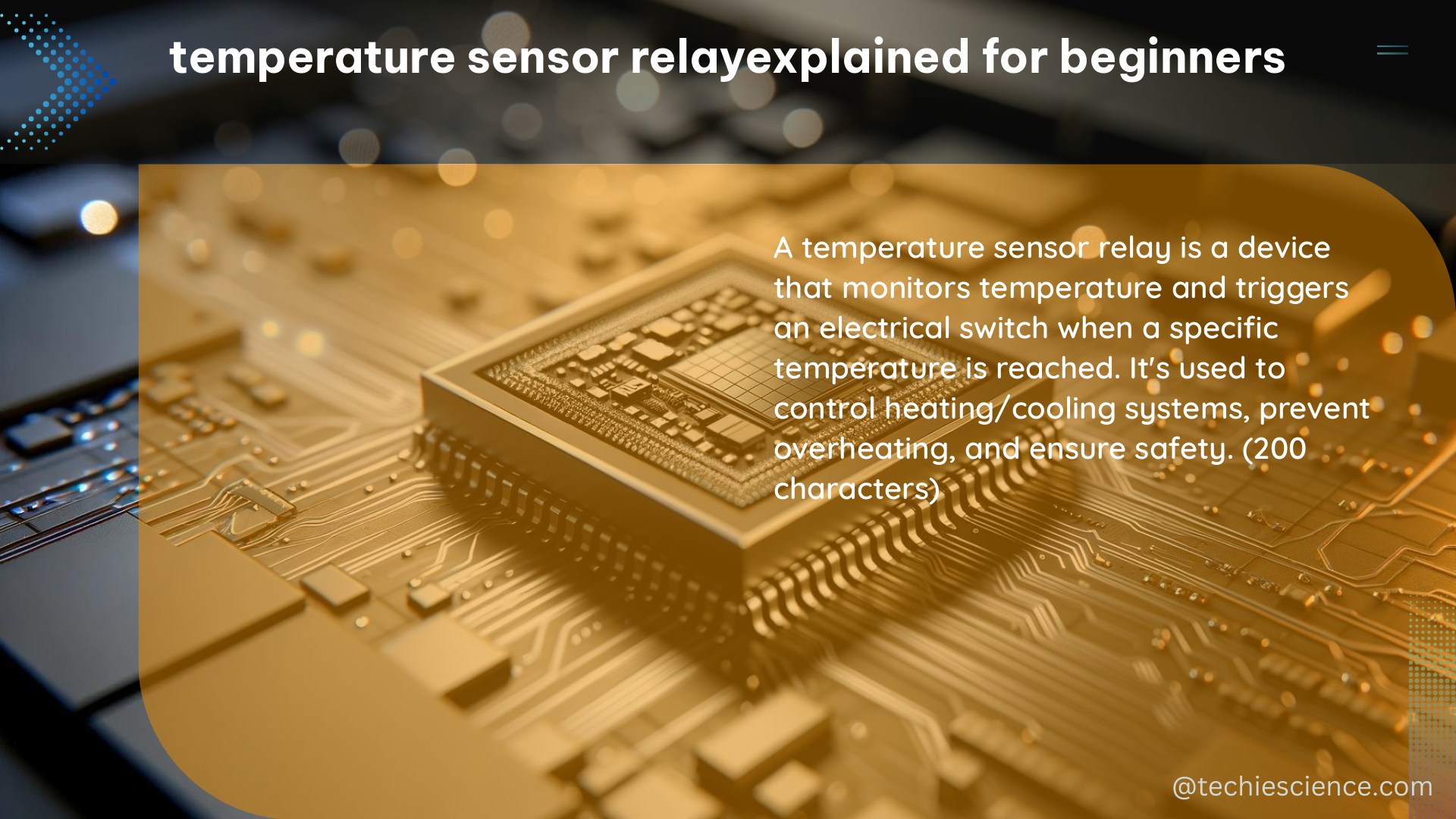Temperature sensor relays are essential components in various applications, including HVAC systems, industrial automation, and laboratory research. They provide precise temperature measurement and control, ensuring optimal system performance and energy efficiency. This guide will explain the fundamentals of temperature sensor relays, their technical specifications, and a DIY approach for beginners.
Temperature Sensor Relay: The Basics
A temperature sensor relay is an electro-mechanical device that converts temperature changes into electrical signals, which then activate or deactivate a relay to control other devices or systems. The temperature sensor, often a thermocouple, RTD, or thermistor, measures the temperature and sends the signal to the relay. The relay, in turn, switches on or off based on the temperature reading, thereby controlling the connected system.
Temperature Sensor Relay Technical Specifications

Temperature Range
The temperature range of a sensor relay varies depending on the type of temperature sensor used:
- Thermocouples can measure temperatures from -200°C to 2000°C.
- RTDs (Resistance Temperature Detectors) are typically limited to -200°C to 650°C.
- Thermistors offer a more limited range, usually from -55°C to 125°C.
Accuracy
Accuracy refers to how closely the sensor relay measures the actual temperature. It is usually expressed as a percentage of the full-scale output or in degrees Celsius or Fahrenheit. For example, a sensor relay with an accuracy of ±0.5°C can measure the temperature within a range of 0.5°C of the actual value.
Response Time
Response time is the time it takes for the sensor relay to respond to a temperature change. A faster response time ensures more precise temperature control. Typical response times for temperature sensor relays range from 0.1 seconds to 10 seconds, depending on the sensor type and design.
Relay Contact Rating
The relay contact rating indicates the maximum current and voltage the relay can handle without overheating or failing. It is essential to choose a relay with a contact rating suitable for the connected load. Common relay contact ratings range from 1 Amp to 30 Amps, and 24 VDC to 240 VAC.
Operating Environment
The operating environment includes temperature, humidity, and vibration conditions that the sensor relay can withstand. It is crucial to select a relay that can operate reliably under the specific environmental conditions of the application. Temperature sensor relays are typically rated for operating temperatures from -40°C to 85°C, and humidity levels up to 95% non-condensing.
DIY Approach for Beginners
To build a simple temperature sensor relay, you will need the following components:
- Temperature Sensor:
- Thermocouple: Measures temperature based on the thermoelectric effect, with a typical temperature range of -200°C to 1800°C and an accuracy of ±0.5% to ±2%.
- RTD (Resistance Temperature Detector): Measures temperature based on the change in electrical resistance of a metal, with a typical temperature range of -200°C to 650°C and an accuracy of ±0.1% to ±0.5%.
-
Thermistor: Measures temperature based on the change in electrical resistance of a semiconductor, with a typical temperature range of -55°C to 125°C and an accuracy of ±0.5% to ±2%.
-
Signal Conditioning Circuit:
- This circuit converts the sensor’s output signal (e.g., millivolt, resistance, or voltage) into a format suitable for the relay, such as a 4-20 mA current loop or a 0-5 VDC voltage signal.
-
The signal conditioning circuit may include amplifiers, filters, and analog-to-digital converters (ADCs) to ensure the signal is compatible with the relay.
-
Relay:
- Choose a relay with an appropriate contact rating and coil voltage to match the connected load and power supply.
- Common relay coil voltages include 12 VDC, 24 VDC, and 120 VAC.
-
The relay contacts should be rated for the maximum current and voltage of the connected load, with a safety factor of at least 1.5.
-
Power Supply:
- Provide a stable power supply for the temperature sensor, signal conditioning circuit, and relay coil.
-
The power supply should be capable of delivering the required voltage and current for the entire system.
-
Enclosure:
- Use a suitable enclosure to protect the temperature sensor relay components from the operating environment, such as dust, moisture, and physical damage.
- The enclosure should be rated for the appropriate environmental conditions, such as NEMA or IP ratings.
Steps to build the temperature sensor relay:
- Connect the temperature sensor to the signal conditioning circuit.
- Connect the signal conditioning circuit to the relay’s coil.
- Connect the relay to the power supply and load.
- Test the temperature sensor relay using a known temperature source, such as a calibrated temperature bath or oven.
- Mount the components in the enclosure and seal it to protect from the environment.
By following these steps, you can create a simple and functional temperature sensor relay for your DIY projects or small-scale applications. Remember to carefully select the components based on the specific requirements of your application, such as temperature range, accuracy, and environmental conditions.
References:
- Unmanned Aircraft Systems: UAV Design, Development and Applications, https://perpus.univpancasila.ac.id/repository/EBUPT200208.pdf
- Senior Design – Biomedical Engineering, Boston University, https://www.bu.edu/eng/files/2022/07/2022-BME-SDP-book-6E2.pdf
- Guide to MBSE with SysML, Sparx Systems, https://sparxsystems.com/resources/user-guides/16.1/guidebooks/mbse-and-sysml.pdf

The lambdageeks.com Core SME Team is a group of experienced subject matter experts from diverse scientific and technical fields including Physics, Chemistry, Technology,Electronics & Electrical Engineering, Automotive, Mechanical Engineering. Our team collaborates to create high-quality, well-researched articles on a wide range of science and technology topics for the lambdageeks.com website.
All Our Senior SME are having more than 7 Years of experience in the respective fields . They are either Working Industry Professionals or assocaited With different Universities. Refer Our Authors Page to get to know About our Core SMEs.